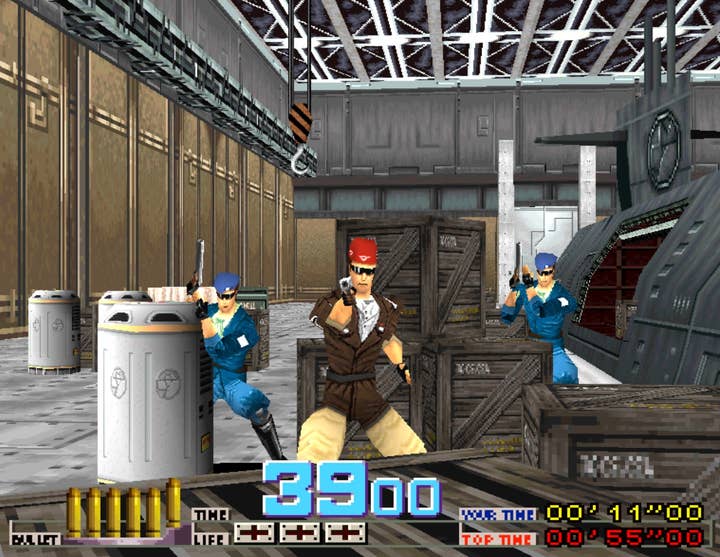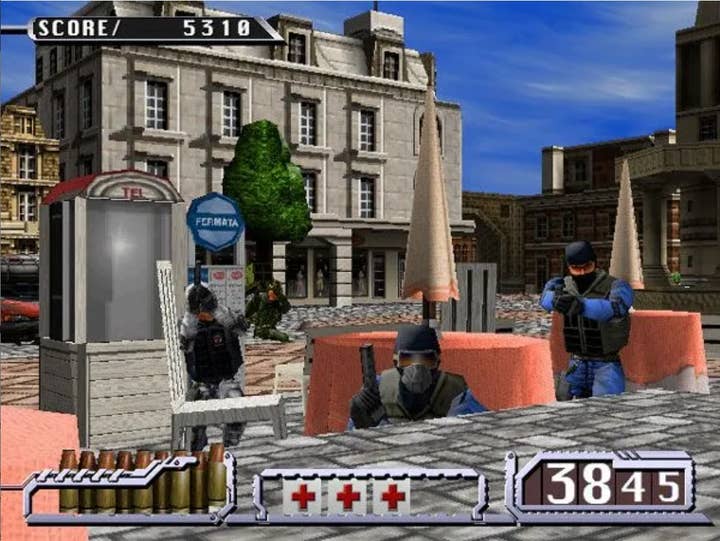Time Crisis | Why I Love
Co-founders of Sigtrap Gary Lloyd and Luke Thompson take aim at the lightgun franchise that inspired their latest game
Why I Love is a series of guest editorials on GamesIndustry.biz intended to showcase the ways in which game developers appreciate each other's work. This entry was contributed by Sigtrap co-founders Gary Lloyd and Luke Thompson, who launched the Time Crisis-inspired Under Cover on Meta Quest earlier this month.
Arcade lightgun shooters give us a huge dose of nostalgia, taking us right back to the arcades of our youth where we would always make a beeline for those cabinets adorned with those chunky plastic guns.
Time Crisis was always the first choice. There was something about the physicality of holding the lightgun, the satisfying sound of that distinctive "clack" as you pulled the trigger and, of course, pumping the famous pedal that you use to duck in and out of cover to reload.

Time Crisis makes you feel like a badass. It's an over the top, late '80s/early '90s-action-flick-fuelled power fantasy that is fundamentally silly on so many levels, but something you are willing to suspend your disbelief for to play your role as the action hero. The pedal-driven reloads made it stand out from everything else and helped give the game an almost rhythmic feel, ducking in and out of cover and popping off shots with a sense of flow that no other lightgun shooter delivered.
Dated as the visuals may now appear, they have a visual identity that of their own. Indeed, it's an aesthetic we've seen developers return to in recent years, just as 16-bit-inspired pixel art enjoyed a revival once we got past the idea that it was passe. The 2D explosions, limited polygons, hard angles, texture sizes and old-school shadows all come together in a package which is incredibly nostalgic for us, but also feels appropriately colourful, brash and ostentatious for the Time Crisis series.
Time Crisis 1 was a fantastic game, but it did sometimes feel a bit unfair. It didn't telegraph which ranged enemy shots were going to damage you, so it felt a bit random. Time Crisis 2 is where the series really hit its stride in our opinion.The game introduced the "crisis flash" system, which would alert you as to whether an attack would cause a direct hit. We think this works so well that we borrowed it for our Time Crisis-inspired shooter, Under Cover (along with the ducking to reload mechanic).
This helped ensure that even when the game got unreasonably hard – they really want your quarters after all – the combination of the cover system and the telegraphs made you feel like it was your fault and you could do it with another try.

In Time Crisis 3, we got the introduction of player-swappable weapons. Your pistol had to be reloaded as normal, but you also got an ammo-limited machine gun, shotgun and grenade launcher. To be honest, it could be a bit fiddly, requiring too many trigger pulls to get back to the weapon you want, which is why we went for a weapon pickup system more similar to Virtua Cop in Under Cover. Nonetheless, having more weapons that put more power in your hands was still a hell of a lot of fun.
Something that carries across the whole series and is a big part of the appeal of the Time Crisis series isn't even in the game itself - though the game includes systems that encourage it. That's the social narrative that players inject themselves.
Competing with friends on co-op cabs to see who is better, or having spectators and friends gather round and collectively moan as you get caught off guard by that one red enemy that pops out and delivers a killing blow. You remember those moments in-game and, on another play, try not to make the same mistake twice.
Through this, the Time Crisis series always managed to have two aspects. Its over-the-top action movie nature, bold visuals and the instant appeal of the gun-and-pedal combo instantly welcomed everyone in and everyone could have fun with it. If you wanted to, however, there was a truly tricky game to master. Every run offers the potential to get better, to refine your skill and your understanding of what's coming next, and better your score. Of course, we loved Time Crisis enough to be captured by that latter dimension.
Nostalgia is a powerful emotive force. It's why Time Crisis has never left our hearts and why you can see so much of its influence in Under Cover. God bless that clacky plastic pistol and pedal combo.
Developers interested in contributing their own Why I Love column are encouraged to reach out to us at news@gamesindustry.biz.






.jpg?width=291&height=164&fit=crop&quality=80&format=jpg&auto=webp)

